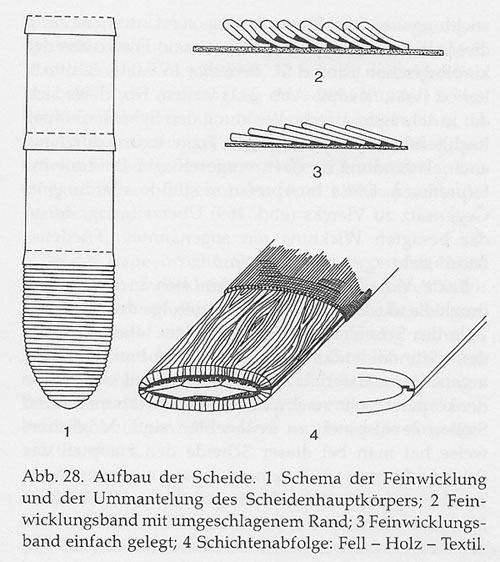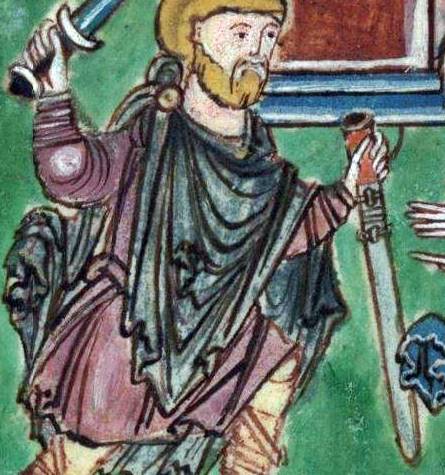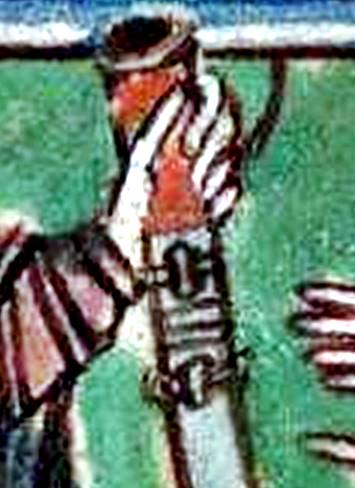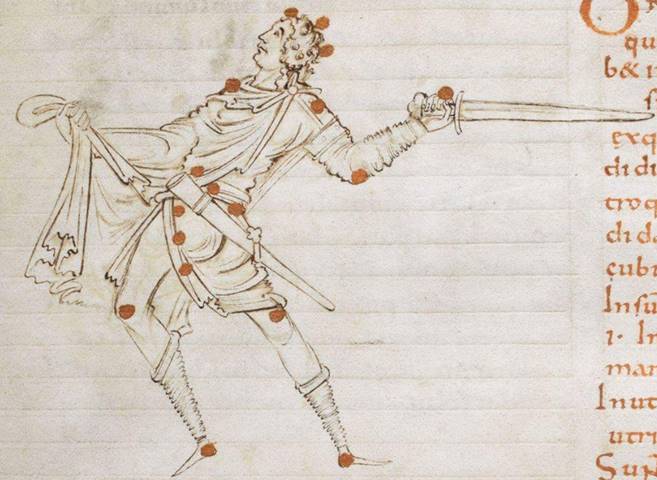- The most common covering for scabbards was linen. I think this was not glued on but rather waxed linen sewn onto the wooden core. I dug up a description of the Emperor Charlemagne that mentioned a waxed linen scabbard covering.
- Many scabbard cores consisted of two halves that were not glued together.
- The previous point may also explain the 'cross ties' i.e. X and Zig-Zag shaped cords or ribbons/straps that seem to be tied around some scabbards in illustrations. Perhaps they were there to keep the scabbard halves together?
- Leather was relatively uncommon as a covering and when it was used it there was a layer of (probably) waxed linen underneath. Geibig says leather covering cannot be proven on any surviving German scabbards but there is an example from Iceland that I know of (Sķlastašir 4) and at least one of the scabbards from Cronk Moar that were leather covered on top of a layer of linen. Also some surviving scabbards from Norway are leather covered.
- Leather covering sometimes took the form of strips of leather wrapped around the scabbard (did not expect that).
- There were very few metal fittings on these scabbards as a rule, usually none (except maybe for belt buckles and D rings), and when metal fittings were used they were probably usually made of iron.
- Metal chapes were very uncommon. In Iceland only 5 or 6 have been found for a total of 24 swords and in Norway a similar number for some 2000 swords. Can't speak for the rest of Europe.
- Scabbard sliders do not seem to have been terribly common during this period, at least not in Iceland/Norway because I'm not aware of any surviving examples. I have heard the argument that hey were probably all made of perishable materials but quite frankly I find that hard to believe. If scabbard sliders were common there should be at least a few surviving examples made of metal or bone.
- Not sure about scabbard lockets/mouths. Does anybody know how common they were?
So basically we all have a very non-period correct fetish for leather and expensive artistically patterned metal fittings. The normal Viking would have carried a scabbard that looked like this excellent reproduction by forum member Tim Jorgensen although I have an issue with the slider (wish he'd post a higher res image):
https://myArmoury.com/talk/viewtopic.php?p=211888
[ Linked Image ]
...and not like this sumptuous example (or my own pimped up scabbards for that matter):
[ Linked Image ]
...although I'm sure that there were a few Earls/Kings/Emperors who could afford an example like this. The whole discussion just goes to illustrate my chief complaint about re-enactment events, too many earls, too few vikings :-)
Also, there is one thing that I've been pondering. Many of these linen covered scabbards seem to have had a chape that consisted of a tightly wrapped linen spiral as illustrated in the attached scan from Geibig's book and reproduced by Tim. However, the thing I'm still not sure about are the cross-tied, zig-zag and spiral cords/strips wrapped around the scabbards and illustrated in the second scan from Geibig's book (which unfortunately does not show in the post). Tim reconstructed these as being decorative and under the linen wrapping. They may have been under the linen or leather cover but I'm having trouble with these things being decorative. Surely these cross ties would have served some purpose? Were they on top of the covering? Did they hold the halves of the wooden scabbard core together?
I can se how No. 10 for example would be the ribbon of the linen chape wrapped as reproduced by Tim in a long spiral around the rest of the scabbard. I tried reconstructing some of these other cross ties with a bit of string and some of them look plausible like No 5,7,9,12 and 13. Other ones like No. 1, 4, 6 and 8 just fall off when I try to reproduce them with a bit of string. Any ideas on what these cross ties would have looked like on an actual scabbard?

[ Download ]


